ARTICLE AD BOX

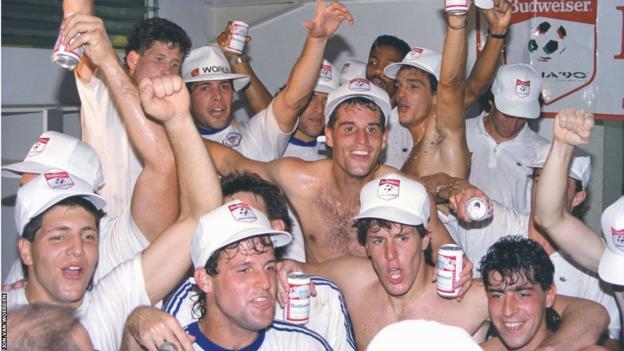 The United States team celebrate the victory that secured their qualification for the 1990 World Cup. Goalscorer Paul Caligiuri (in the back row) is wearing a Trinidad and Tobago hat handed to him by their federation president Jack Warner
The United States team celebrate the victory that secured their qualification for the 1990 World Cup. Goalscorer Paul Caligiuri (in the back row) is wearing a Trinidad and Tobago hat handed to him by their federation president Jack WarnerSign up for notifications to the latest Insight features via the BBC Sport app and find the most recent in the series.
On a Saturday evening in February 1990, many of the United States' finest footballers stepped on to A&M Studios' historic soundstage in Los Angeles.
A month before John Barnes would implore his England team-mates to "hold and give, but do it at the right time" in a studio in Berkshire, the United States team were there to record their own rap - one they hoped would make the sport famous in the USA.
In a moment, some of Hollywood's biggest celebrities would walk through the door to join them.
The plan was to record a novelty music video for a star-studded jock jam called Victory. The track celebrated the United States' first trip to the World Cup in 40 years, long before any of these players were born.
Never mind fame, though. In 1990, making football a little less hated in the United States would have counted as a runaway success.

Americans mostly considered football a fringe concern - if they even considered it at all. Baseball, American football and basketball were the "real" American sports.
For most of the 20th century, football in the States was for "the others", to put it politely: expats, cab drivers, dishwashers, exchange students, leftists, intellectuals, Euro snobs and the like.
Still the US Soccer Federation were constantly thinking about how to grow the game.
Werner Fricker, the federation's stern but visionary president, had cannily realised Fifa's desire to wring American dollars out of the world's most popular sport. By 1988, he had guided the United States to victory over Brazil and Morocco to win the right to stage the 1994 World Cup.
But Fricker knew a World Cup in the States faced scepticism. He wanted to prove the hosts had a team good enough to qualify on merit.
He put up his own money to fund a push to qualify for the 1990 event. If the United States succeeded it would be the first time they had made the World Cup since Brazil 1950, where they earned their place via a second-place finish in a three-team pool.
"Werner refused to accept that qualification wasn't doable," said Kevin Payne, former director of marketing and national administrator for the Federation. "He knew what needed to be done, and that past attempts were amateurish."
Fricker made Bob Gansler the team's first full-time coach. A tough yet erudite German-Hungarian immigrant, Gansler's knowledge of American youth football ran deep.
The team picked by Gansler, many fresh out of college, had been raised during the North American Soccer League's Pele-led glory days and were a clean slate from past failures to reach the World Cup.
They had chips on their shoulders for all sorts of other reasons though.
Many of them were second-generation immigrants, their parents and family lives different from an 'apple pie' American ideal. They loved a sport that many around them reviled and yet there was no nationwide outdoor league for them to play in.
Instead, most of the squad either played the indoor game or on teams in the so-called ethnic leagues found in large cities.
Only three players had contracts in Europe.
The Federation decided to offer many of the rest small, centralised contracts so that they could train full-time. The result was a national team that was more like a club team, playing matches and ad-hoc tournaments against nearly any club or nation that would agree to them.
At the heart of it was the midfield duo of Tab Ramos and John Harkes, both raised on the hard, asphalt courts of Kearny, New Jersey.
The forward line featured the industrious Peter Vermes and the physically imposing Bruce Murray, a big man with little-man ball skills. John Stollmeyer, seemingly carved out of granite, was the midfield enforcer while Mike Windischmann, a Germany-born, quiet kid from Queens and a former ball boy for the New York Cosmos, was sweeper and captain.
Midway through qualifying, a 20-year-old friend of Ramos and Harkes from Kearny became the starting goalkeeper: Tony Meola.
They didn't know it at the time, but this 1990 team would become the founding fathers of modern US football.
"None of us were alive in 1950," said defender Paul Krumpe. "And since 1990, the US has put on such a good string of qualifying for every World Cup [except for 2018]. So this absolutely was the origin group."
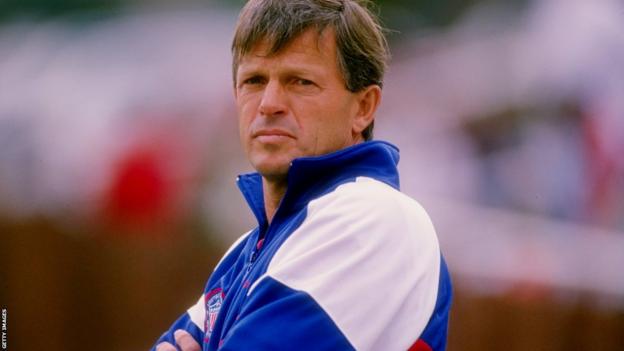 The appointment of Bob Gansler was part of a push by the US Soccer Federation to prove they were worthy hosts and competitors for the 1994 World Cup
The appointment of Bob Gansler was part of a push by the US Soccer Federation to prove they were worthy hosts and competitors for the 1994 World Cup"We used to get out of the bus and they'd throw bags of [urine] on us," Vermes said.
"My first national-team game was in Guatemala in 1988 and I remember defending a corner kick and hearing 'ding! ding!' on the crossbar and post.
"The crowd was throwing size D batteries at us. You would go take a corner kick and guys in the crowd would be spitting on you. It was crazy. It was a totally different time."
The United States had to play three games in Central America during qualifying for the 1990 World Cup. Geopolitically, this was a complicated time to do so.
The Central Intelligence Agency and Department of Defense had been meddling in Central American countries for decades, and by the 1980s it was coming to a head.
One of the teams in the United States' five-strong qualifying pool was El Salvador, a country in which the US had propped up a right-wing government in a long civil war that had claimed 70,000 lives and displaced more than one million people.
Because of crowd trouble in El Salvador's previous World Cup qualifier, the United States' away match against the Salvadorians was staged in neighbouring Honduras, where the CIA was also active.
The United States team bus was surrounded by commandos and equipped with a machine gun turret.
It was similar when the United States played Guatemala, in the midst of a 30-year civil war started by a US-backed coup. There the team were shadowed by plainclothes bodyguards carrying tennis racquet cases, but perhaps not racquets.
Aside from the political backdrop, games in Central America were never easy. Fans hired bands to play outside the visitors' hotel rooms or lit fireworks. The US' designated practice pitch was hardly a pitch at all. The air conditioning mysteriously stopped working the night before the game.
Over seven months of matches, it all came down to the final tie - away to Trinidad and Tobago with the 24th and final spot in the 1990 World Cup at stake.
The United States needed a win yet hadn't scored a goal in their previous two games. Trinidad and Tobago, which would become the smallest nation to ever reach the World Cup, only needed a draw.
And their 'Strike Squad', as the team were known, hadn't lost at home in nearly two years.
All week in their dingy Florida training camp, the stakes rose even higher for the United States team. A rumour emerged that if the Americans didn't win this game and reach the World Cup, Fifa might take away their hosting rights for 1994.
That meant if they lost, there'd be no more football for them to play. What little existed of football in the US would disappear. Their contracts would be gone. They would all have to get day jobs. Some players were about to get married, others had purchased homes.
The United States team was used to fighting for every scrap of publicity they could at home, so nobody was prepared for a game of this magnitude. Stepping off the plane in Port of Spain at midnight, two days before the match, thousands of locals all dressed in red greeted the team on the tarmac, in the terminal, even on the roof of the airport singing, chanting, playing drums.
As the Americans drove to their hotel, locals three-deep lined the highway, dancing and singing a catchy calypso chant that continued all night long: "T&T, we wanna goal!"
The Trinidad government had even declared the day after the match a national holiday. They were certain they were going to the World Cup.
This was totally disorientating. The Americans had left their own, powerful country where football was the least important thing on earth and landed on a tiny island where it was the only thing on earth. It was obviously intimidating to be so outnumbered. But the tone wasn't savage - it was festive. The American team fed off it. Finally they had a big game of their own, just like in the movies.
All night before the game, local policemen had run their squad-car sirens outside the Americans' hotel windows. On the way to the stadium, the Americans' bus couldn't move. A crowd of 100,000 were outside the stadium and in the streets, all dressed in red. The Trinidad and Tobago Football Association had sold two tickets for every seat, and the scenes around the stadium were total chaos.
Gansler's pre-game talk wasn't emotional, it was typically straightforward: the American plan was to attack quickly themselves and pin their opponent back, frustrating both the home team and their crowd.
They exited their dressing room with nerves like they've never felt before and lined up in the tunnel, looking into the white light ahead. Trinidad's players lined up alongside them, but something felt off.
"I remember looking at their guys and thinking to myself, 'they're not ready for this'," Vermes said. "You could see fear in their eyes. I knew right then we were winning. They were under so much pressure that they were scared."
The stadium looked like a carnival. The pre-game festivities featured local pop stars, a military marching band, feathered dancers, a colour guard team and a fire engine driving around the field, hosing off the crowd.
The pitch, however, resembled a car park - dry and bumpy. It was hot and windy. The sun was so intense that players had trouble seeing. The first 20 minutes were nervy.
Eventually, Trinidad and Tobago began attacking in wave after wave, their speed and dribbling having pinned back the US.
Then in the 32nd minute, from a United States throw-in, the ball found midfielder Paul Caligiuri. He prowled towards the goal, all the while trying to control a ball that wouldn't stop bouncing. He manoeuvred past one defender then - from 35 yards out and with no-one closing him down, the wind in his face and the sun at his back - the ball sat up perfectly. He lashed his foot across it and the ball sailed towards the goal in a high, looping arc.
"I thought 'there's no way he's hitting this', but he just smacked it and the ball dipped like crazy," Harkes said.
The goalkeeper's sight was blocked by his defenders and the sun was in his face. He made a late, weak leap to his side, but the ball plopped down on the other side of the goal line, past his glove.
After 239 minutes without a goal, Caligiuri - a defensive midfielder who was instructed not to attack, never mind shoot - had just scored the United States' biggest goal in decades, maybe ever. The crowd wasn't exactly silent - they were almost shrieking in horror.
Trinidad had a few close chances in the second half but the United States dug deep and defended hard.
At the final whistle, the Americans collapsed on the ground in the golden late afternoon light. They'd done it. They had reached the World Cup when almost no-one expected them to, securing their own futures and that of the game in their homeland.
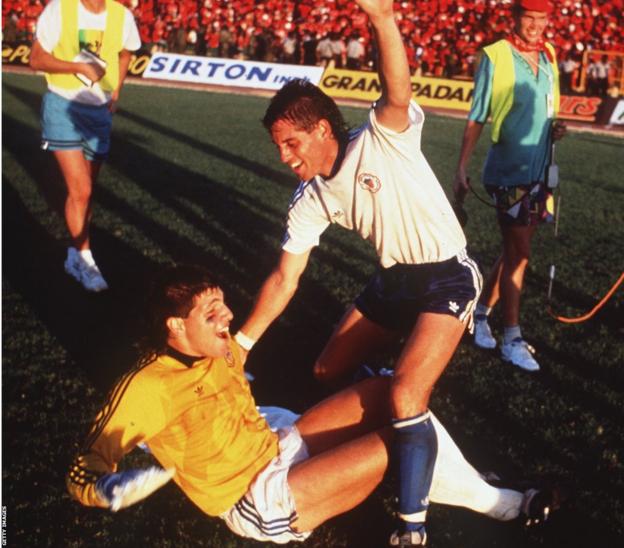 Tony Meola and John Harkes - childhood friends from New Jersey - celebrate beating Trinidad and Tobago to make the World Cup
Tony Meola and John Harkes - childhood friends from New Jersey - celebrate beating Trinidad and Tobago to make the World Cup"There's no doubt that Gansler prepared us really well for tough moments," Vermes said. "He knew we were going to have to survive tough moments. That's one of the biggest reasons why we won that game, because we had a tough mentality as a group."
Their locker room was small, sweaty and full of Budweiser beer - one of the federation's biggest sponsors. The staff hadn't even purchased champagne beforehand. But soon, a trolley of bubbly appeared: it was Trinidad's. They certainly were not going to drink it now, and so it was magnanimously gifted to the Americans by Jack Warner, president of the Trinidad and Tobago Football Association.
On a handmade poster listing the 23 teams who qualified for the World Cup, Meola, the goalkeeper, wrote 'USA' into the final spot. As the team celebrated, Gansler, meanwhile, sat back and quietly took it all in.
"Bob was in the corner and, I'll never forget this, kept saying 'just another game' to everyone who congratulated him," said Murray.
Yet the USA's first trip to the tournament in 40 years was hardly news at all back home. The game itself was shown on tape delay after an American football game, and only 432,000 people out of a population of 248 million watched it.
A few weeks later, at the glitzy World Cup draw in Rome, actress Sophia Loren pulled out the ping pong balls and passed them to Fifa secretary general Sepp Blatter. The United States would share a group with hosts Italy, who had won the World Cup seven years before, and two solid European sides in Czechoslovakia and Austria.
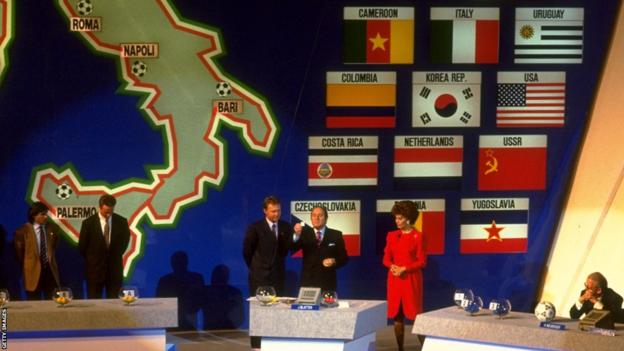 Sophia Loren (in red) and Sepp Blatter (to the left of Loren) make the draw for the 1990 World Cup
Sophia Loren (in red) and Sepp Blatter (to the left of Loren) make the draw for the 1990 World CupThe United States team may have been anonymous to most Americans, but they had a few friends in high places. One of them was Shelli Azoff, wife of music industry mogul Irving Azoff.
Two years before, Caligiuri had wangled an invitation to an exclusive party thrown for George Michael in the Hollywood hills. Among others there, he had met Shelli, who had known other footballers. She previously tried to help Caligiuri's UCLA team-mate David Vanole get a try-out at Watford, owned at the time by the Azoffs' friend Elton John.
Azoff instantly saw the potential for this team.
"They all were good-looking. They were smart. They all were nice guys and represented the best of America, so I tried to get them some media attention," Azoff said. "Especially for the United States, the underdog, to get into the World Cup for the first time in forever, I thought would be a great opportunity."
They deserved to be famous. With some clever marketing, maybe they could be.
Caligiuri had recently recorded a rap song with his college room-mate, a trained musician, for fun.
He played it for Azoff and she began calling in favours from music video directors, record label executives, MTV executives, producers and her celebrity friends.
That night in February 1990 at A&M Studios, most of the team heard the new version of Caligiuri's song - rewritten and recorded by emerging hip-hop artist Def Jef - for the first time. It was now called Victory.
Suddenly, star athletes and celebrities began walking through the door to join them, including American football's Marcus Allen, ice hockey's Luc Robitaille, TV star Cathy Lee Crosby and Nitro from American Gladiators.
OJ Simpson - the gridiron legend-turned-film star, whose subsequent arrest and acquittal on murder charges transfixed the world - was another of those to gather around the microphone with the players.
"These people just started popping up in the studio, it was like: 'We're in the big time, man!'" said defender Desmond Armstrong. "You just had to pinch yourself and say: 'Don't ask them for an autograph!'"
The next day, the team filmed additional scenes on Carbon Beach near the Azoff's Malibu home, stripping down to shorts to juggle a ball, horse around in the surf and approximate the 'running man' dance.
"Togetherness and unity means victory for you and me," rapped the squad over the top of the footage.
The video premiered that spring on MTV and other music video channels, but seldom afterwards. They had found a way to get football into the living rooms of America, but not even the celebrities of the era could help make it popular.
"I think we thought we were going to ride a wave and people were going to follow us - but nobody cared," said Armstrong.

As their bus pulled up outside their Italian training camp for the first time, it looked more like a military base to the United States players.
A high fence, crowned with barbed wire, surrounded the complex in Tirrenia, on the outskirts of Pisa. It was an old Olympic training facility that looked like it hadn't been used for many Olympics. The living quarters were like barracks. The eating area looked like a prison canteen. The menu seemed to consist entirely of pasta.
At least the training pitch was nice.
Tirrenia had been recommended to them by Italy's World Cup host committee as the only suitable and available training base anywhere near Tuscany.
To a hungry American team overjoyed to finally reach the World Cup, staying here felt like punishment. Before their first game, against Czechoslovakia, Gansler ratcheted up the training intensity. In this setting, it felt like they were preparing for war.
Their first game, though, ended in disaster. After the United States looked lively and dangerous for the opening 20 minutes, Czechoslovakia realised how naive their opposition's tactics were - reliant on man-marking - and pulled them all out of position.
Forward Eric Wynalda, a day after his 21st birthday, was baited into a red card early in the second half.
Caligiuri scored a sensational goal on a 60-yard run, starting in his own half, but it was mostly forgotten as Czechoslovakia ran out 5-1 winners.
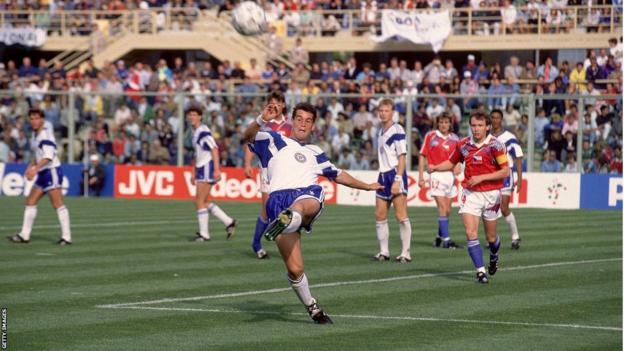 The United States' campaign began with a heavy defeat against Czechoslovakia at Italy 1990
The United States' campaign began with a heavy defeat against Czechoslovakia at Italy 1990After 40 years away from the World Cup, the next morning's headlines were not kind to the Americans. "USA: What a Delusion," wrote Corriere della Sera. Gazzetta dello Sport noted the "century of difference" between the United States and Czechoslovakia. The Times explained that the US "were utterly exposed by such Bronze Age devices as an overlapping full-back".
Next up was Italy, in Rome. The Americans had three days to pull themselves together.
"There were a lot of deep thoughts among the players," Harkes told the Guardian of the build-up. "'Are we really up for this?'"
Practices got even more intense. The second-string players were upset at having to mimic their opponents in order to train the starters - who had played badly and perhaps didn't deserve to keep their starting spot.
One afternoon, a fight broke out. Forwards Bruce Murray and Eric Eichmann, former college team-mates, traded punches as they got tangled up in the goal net. The squad quickly rushed in and broke it up. Then, oddly, everyone started laughing.
A pressure valve had released. Now they could focus on their next opponent, not their last.
Behind his sunglasses it was impossible to know what Gansler made of this melee. Most players assumed he was pleased to see some fight in his boys, even if it was literal.
Before the Italy game, the worldwide press genuinely debated whether the United States would lose by 10 goals or more. Italy's press pack were cheerfully predicting a goleada, meaning a rout. After the Azzurri won their first game 1-0 against Austria, a slaughter of the United States would be the main course for the expectant host nation.
No-one gave the United States any chance at salvaging their dignity, never mind getting a result. After all, the Azzurri were stacked with such legends as Walter Zenga, Franco Baresi, Paolo Maldini, Gianluca Vialli, Roberto Donadoni and Roberto Baggio. Many of the United States players were playing for a few hundred bucks on weekends in short-lived regional football leagues in front of a few hundred spectators.
The day before the match, the United States drove to Rome. Everyone on the street who saw the team bus drive past held up two hands. Inside the bus, Armstrong waved back at them with one hand. Finally, their translator spoke up. "You know what they're saying, don't you?" he said to Armstrong.
"No man, what?"
"They're saying you're going to lose by 10 goals, and you're telling them you're only going to lose by five."
Pope John Paul II - a former goalkeeper - moved the day's Corpus Domini parade forward one hour so that Italians wouldn't miss a single goal. The whole nation - and possibly the heavens - was against the Americans. Just as in Trinidad, they were under siege: 73,000 people in the stadium were expecting a bloodbath.
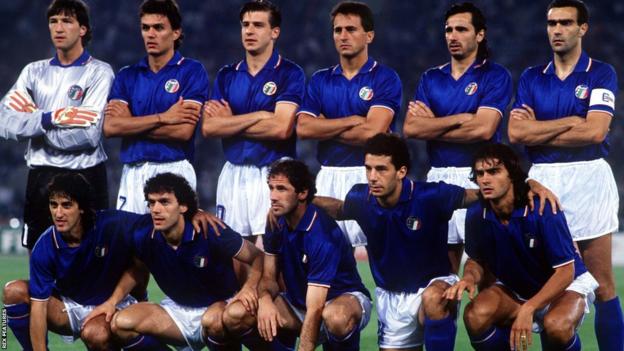 Italy's star-studded starting line-up included a 21-year-old Paolo Maldini (back row, second from left), his AC Milan team-mate Franco Baresi (front row, centre) and Gianluca Vialli (front row, second from right)
Italy's star-studded starting line-up included a 21-year-old Paolo Maldini (back row, second from left), his AC Milan team-mate Franco Baresi (front row, centre) and Gianluca Vialli (front row, second from right)When both teams lined up in the tunnel, Donadoni encouraged American defender John Doyle, at the front of the United States' line, to walk out first. Doyle naively thought this was a nice gesture and led his team out on to the pitch. A deafening number of boos and whistles cascaded down from the stands. It was a trick. Then a few seconds later, the terrible din turned to roaring as the Azzurri took to the pitch.
This was a far bigger crowd than this United States team had ever played before. But Gansler, as usual, had a plan. Rather than always trying for a quick counter-attack whenever they got possession, the United States would attempt to slow the game down. Keep possession, he told his team. It would frustrate the Italians and their expectant fans.
The first few minutes were nervy: cautious attacking, physical defending. Then in the 11th minute, Italy sliced through the American defence in a devastating four-pass, five-player sequence to make it 1-0. It was so fast the United States didn't know what hit them.
It seemed the goleada was on. But the Americans dug in. In one first-half passage of play, they kept the ball away from Italy for what seemed like minutes. Whenever the United States had the ball the crowd would whistle, but having it this long, the whistling was almost feverish. The Azzurri could not get the ball off the Americans, and the Stadio Olimpico atmosphere became savage. The crowd was turning against its own team. Gansler's plan was working.
But then in the 33rd minute, Italy won a penalty. The crowd vibrated once again with anticipation, but Vialli hit the post. In the way that missed opportunities can change matches, the first half finished limply.
At half-time, the United States felt good. Everyone stressed that they needed to keep playing their game and remain patient, a chance would come.
The second half was more of the same: nervy, technical play with missed chances. Then around the 70th minute, Italy defender Riccardo Ferri elbowed forward Murray in the face. Murray 'thanked' him, Ferri replied in kind, expletives overcoming the language barrier. Was this the United States' chance?
The free-kick was 25 yards out. Murray ran on to it and hit it so hard he nearly fell over. Zenga could only parry it into the path of Vermes. Vermes saw Zenga spring back to his feet and shot hard and low, straight between the keeper's legs. It was perfectly struck - but hit Zenga's buttocks as he fell backwards, taking the fizz off the shot.
All the noise in the stadium disappeared as the ball rolled slowly towards the open goal.
Two American players rushed to tap home an equaliser, but they were beaten there by Ferri who rescued his team from a problem of his own making, blasting the ball clear and far upfield.
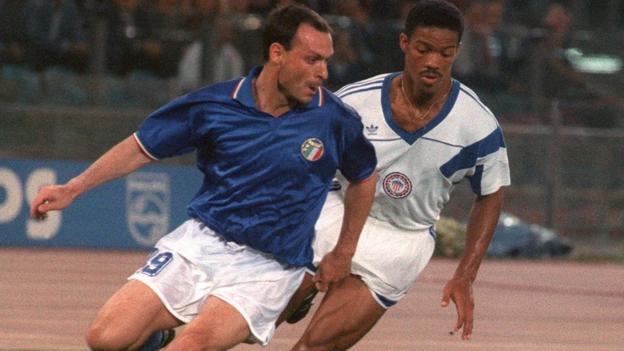 United States defender Jimmy Banks tracks Salvatore 'Toto' Schillaci, who would go on to become the 1990 World Cup's top goalscorer, during the meeting with Italy in Rome
United States defender Jimmy Banks tracks Salvatore 'Toto' Schillaci, who would go on to become the 1990 World Cup's top goalscorer, during the meeting with Italy in RomeItaly created a few more chances, one expertly saved by Tony Meola. But, when the final whistle blew and the game ended, the scoreline was not 10-0 but 1-0.
The crowd initially booed and whistled as hard as they could.
Soon, though, that noise turned to cheers as spectators realised what they had witnessed: Italy's superstars had given their all on the field, not to embarrass the United States, but to avoid being embarrassed.
The Americans had lost, but felt strangely buoyant. Harkes tried to exchange shirts with Ferri. Ferri explained he'd already promised his shirt to someone else, then took his shorts off and handed them to Harkes.
"'This is odd but… OK'," Harkes thought as he handed his shorts to Ferri and exited the pitch in his underwear.
When the Americans reached their dressing room, they felt vindicated in the eyes of the world. As Steve Trittschuh, an unused substitute, reached the dressing room last, he saw a silhouette approaching their door too. It was another unused substitute, this one short and with a braided ponytail. It was Baggio, recently anointed as the world's most expensive player after an £8m move to Juventus. He had come to trade for some American shorts.
Once all were inside the dressing room, the Americans heard a knock. In stepped Baresi, Maldini, Baggio and team-mate Fernando de Napoli. One of them said to the Americans: "We want you to know that your country should be proud of you."
Just 90 minutes before, the Americans were the laughing stock of the football world, yet here were the Azzurri's biggest stars congratulating them personally.
The Italian stars then chatted for a while in the US dressing room, rehashing the game with their American counterparts through their interpreter and exchanging laughter.
After the Azzurri players departed, there was another knock on the door. It was retired boxing legend 'Marvelous' Marvin Hagler, who had moved to Italy and was starring in Rambo-style action B-movies. The players couldn't believe it.
"I just want to say that you guys were great out there tonight," Hagler said. "You made me proud."
This was quite a moment. The Americans were used to the rest of the world loving football, but praise from a sports superstar whom they all admired felt significant. It reminded them of what they had truly accomplished in reaching the World Cup.
Now that Hagler lived outside the United States, he understood. Maybe someday the rest of America would, too.
The United States lost their third game, a bad-tempered, card-filled match against Austria, and finished in last place in their group. Their first World Cup in 40 years was over after three eventful matches.
But their 1990 adventure was an essential first step back into World Cup football in which they learned what to expect, how to prepare, where to stay and how to play at the highest level before hosting the tournament four years later.
 Tony Meola and John Harkes (right), seen overlooking Sheffield's Tinsley Towers, went on trial to Sheffield Wednesday after their Italy 1990 exploits, with Harkes going on to play for the Owls for three seasons
Tony Meola and John Harkes (right), seen overlooking Sheffield's Tinsley Towers, went on trial to Sheffield Wednesday after their Italy 1990 exploits, with Harkes going on to play for the Owls for three seasonsBefore the World Cup, only three Americans were playing in Europe. Within the next year, 10 members of the team had signed contracts with European or South American clubs, including Harkes, who became the first American to play in the Premier League, with Sheffield Wednesday, Murray and Kasey Keller at Millwall and Meola at Brighton & Hove Albion.
Even the off-field connections they made continued to bear fruit. Two years later, Shelli Azoff met a sports attorney on a flight, and in 1996 they helped establish the US national team players' union.
"I played on better teams," said Tab Ramos, a veteran of three World Cups. "But I have to say, the 1990 team is the most important. That '90 team was just different. It was special and had different personalities, and it really set the tone at a time when we really needed it."
It's impossible to imagine football's steady growth in the USA without the exploits of the 1990 team.
Their slog through Central America, their heroics in Trinidad and their redemption in Rome is the story of a bunch of players fighting not for fame - although that would have been nice - but simply the chance to keep playing football for a living, and to give the sport a shot in America.

 1 year ago
118
1 year ago
118
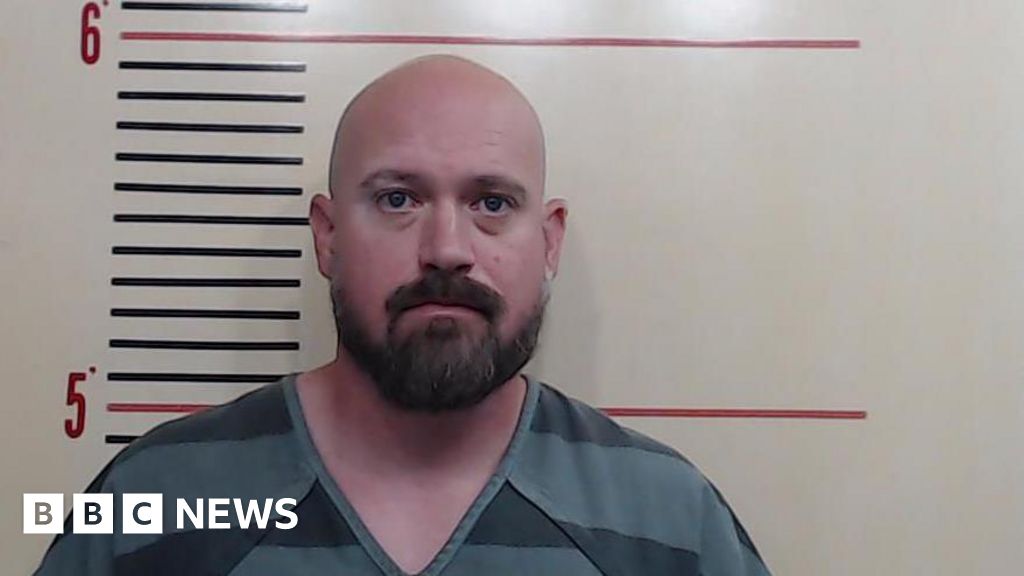

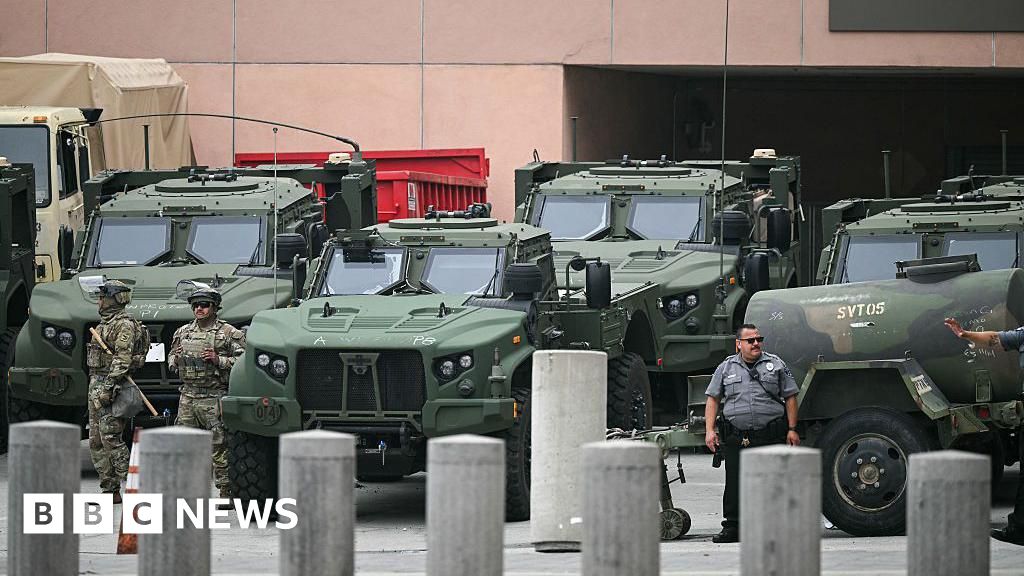





 English (US) ·
English (US) ·